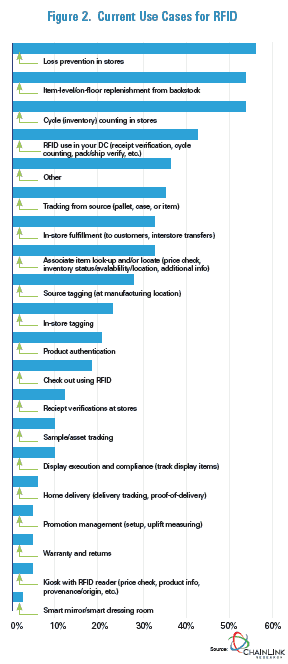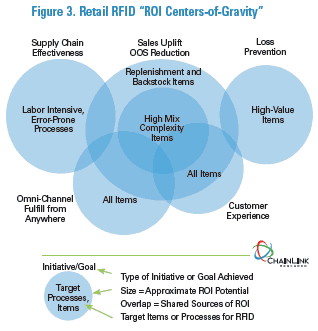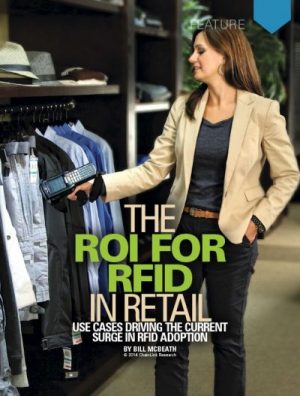Over recent years, we’ve witnessed a resurgence of interest and substantial growth in the use of radio frequency identification (RFID) technology in retail—a veritable RFID renaissance—with more than six billion tags used in 2016 alone, not just in apparel, but for other categories and uses as well.
We wanted to find out exactly what is driving this surge of interest in recent years. Which use cases are being implemented? Which of these use cases have the potential to deliver the most value, and what best practices ensure that value is actually realized? What is planned for the near future? What strategic goals are retailers trying to realize? What can others learn from the current wave of implementations?
To find answers to these questions, ChainLink surveyed and interviewed over 120 retailers, primarily headquartered in North America and Europe, but many with a global retail footprint. From this research, we learned some important lessons on why RFID projects succeed or stall.
EDITOR’S NOTE: This research was sponsored by Tyco Retail Solutions.
Why Are Retailers Adopting RFID Technology?
RFID technology has made huge strides. The retail user community has conducted pilots, learned many lessons, and identified strong use cases. Standards have been established to create interoperability across the supply chain. RFID technology performance has improved greatly, while costs have come down dramatically; item-level tag costs are about a fifth of what they cost in the early 2000s. The technology promises new insights as retailers like Macy’s transform their business operations.
To find out what is driving the current wave of adoption, we asked retailers for their three top reasons why they were implementing RFID (Figure 1).

By a wide margin, the top reason for implementing RFID is to “improve inventory accuracy.” This makes sense; improved inventory accuracy is central to driving sales uplift and many of the other benefits and goals of RFID technology.
Let’s break down how this works: RFID enables cycle counts to be completed about 25 times faster than traditional manual bar code scanning. Frequent, accurate cycle counts improve inventory accuracy, typically by 20 to 30 percent, allowing a number of retailers to achieve 99 percent inventory accuracy. This enables replenishment alerts to be reliably generated, increasing on-floor availability, and decreasing out-of-stocks (OOS), typically by 15 to 30 percent. This in turn results in sales uplift in the range of 1 to 10 percent or more for those categories.
The resulting increase in sales is the fundamental financial driver of most RFID implementations in retail and illustrates the central importance of improving inventory accuracy and reducing OOS. The dominance of this particular driver for RFID implementations is even more pronounced when you consider that three of the answers to our question in Figure 1 are just different aspects of the same core driver—inventory accuracy, reduced out-of-stocks, and increased on-floor availability. When added together, these encompass the prime reason retailers implement RFID.
What Are Retailers Using RFID Technology For?
We asked retailers what they are using or planning to use RFID for (Figure 2). At first blush, this data appears to tell a different story from Figure 1, since “loss prevention in stores” was selected as the most common planned use of RFID. However, we caution against interpreting the results to mean that loss prevention is the primary driver of most RFID implementations.

For this question, rather than forcing respondents to rank their priorities as we did in Figure 1, we asked them to simply check “all that apply.” Based on the responses to all the other survey questions and our interviews, we conclude that the use of RFID for loss prevention, while popular, is in most cases being used in combination with an inventory/replenishment application.
The relative importance of inventory-based RFID applications is also supported by the data in Figure 2, where “item-level replenishment from backstock and cycle counting in stores” are practically tied with loss prevention as the most widespread use of RFID technology. With the exception of some very high-value products such as jewelry, it is not common for RFID implementations to be justified on the basis of loss prevention alone.
In fact, this is a common pattern—RFID is justified based on the ROI for a prime use case, which is typically inventory accuracy, driving reduced OOS, and increased sales. Then once the retailer is using RFID, they explore other possible uses and benefits. Loss prevention is the most common among those other possible uses, but there are many others as well. Supply-chain uses are almost as popular as LP. “RFID in the DC to verify goods receipt, pick, pack, and ship” was selected by over 40 percent, and over one-third of respondents are tracking goods from the source.
Looking further down the list at the wide variety of use cases, it is important to consider there are many types of retailers, store formats, operational models, and product categories, each combination having different use cases that make the most sense for them. Nearly a third of respondents are using RFID technology for both in-store fulfillment and to allow store associates to check on item availability, location, price, and other information. That shows that RFID can be an important component of an omni-channel program (more on this later). Also of note, though source tagging is increasingly common, a surprising number of retailers (nearly 25 percent) are still tagging in the store.
Product authentication, selected by just over 20 percent of respondents, is primarily the domain of luxury goods such as high-end handbags. A few private-label retailers are using RFID for sample management to try and streamline and compress the upfront development process. In addition, private-label retailers are more likely to do source-to-store tracking using RFID.
Display and promotion management, home delivery, and using RFID for warranty purposes have seen some piloting, but few widespread implementations. Using RFID for home delivery is being explored by e-commerce providers, especially for large, complex deliveries requiring on-site assembly and installation, in order to ensure accurate picking and optimized logistics processes, such as precise truck loading sequence and delivery confirmations. Customer experience applications of RFID, such as smart mirrors or kiosks, have gotten their share of media buzz, but are seeing little adoption to date.
The Path to ROI
Many retailers are achieving a strong enough ongoing ROI to justify continual expansion of their RFID technology programs. We explored these to understand how benefits are being realized, what these have in common, and how these programs tend to evolve.
The survey data and interviews reveal certain “ROI centers of gravity,” as illustrated in Figure 3. Others can use these experiences to help determine a value-based path forward for themselves.
Focus on High Mix Complexity Items. One common thread we found in successful implementations is that they usually start with the area of fastest ROI. For most retailers, this is a focus on products with “high mix complexity,” such as size/color/style-intensive items in apparel and footwear, inkjet cartridges, certain cosmetics such as eye shadow, fragrances, and certain sporting goods.
What these categories have in common, besides relatively high price points and margins, is the need to keep many variations on display, so that when the customer walks in the door, they find just the one they are looking for. The primary driver here is tangible—sales uplift resulting from on-floor availability. As mentioned earlier, these are largely a result of the increased inventory accuracy and timely replenishment alerts that RFID applications bring to the table. This is why many retailers start their RFID efforts focused on high mix complexity/size, color, and style intensive products.
Loss Prevention and Supply-Chain Uses. Retailers may expand their RFID footprint in one or more other dimensions. Some have moved from a high mix complexity core set of items, to tagging a broader set of general merchandise encompassing all replenishment items. Others are using RFID as part of their overall loss prevention programs.
Loss prevention benefits can be derived at virtually any point where inventory applications are deployed and are not limited to “RFID as EAS” (electronic article surveillance) installations. As such, RFID for retail LP applications are occurring across the store floor and supply chain—in receiving, in high-theft zones on the selling floor, at the point-of-sale, and in DCs. RFID gives much more precise information about exactly what is being stolen and where, which allows retailers to more effectively target their prevention efforts.
 Footwear has been an interesting category where RFID technology has been used for loss prevention and also for making sure pairs stay together, ensuring the right shoes are on display and enabling store associates to check availability of the customer’s size without leaving their side.
Footwear has been an interesting category where RFID technology has been used for loss prevention and also for making sure pairs stay together, ensuring the right shoes are on display and enabling store associates to check availability of the customer’s size without leaving their side.
Still others—especially private-label retailers—are using RFID to improve supply-chain performance, especially for labor-intensive, error-prone processes, by using RFID to verify pick, pack, ship, ASN generation, store receiving, and inter-store transfers. As a result of RFID-enabled supply-chain processes, some retailers have seen a substantial reduction in errors and increase in accuracies, coupled with a sizeable decrease in the amount of labor required for scanning, inspection, and rework. Almost everyone who implemented RFID in their DCs and supply chain found that it exposed many opportunities for process and performance improvements.
However, with some notable exceptions, many LP and supply chain uses of RFID technology were follow-on efforts that happened after the retailer realized an ROI with the core inventory accuracy and on-floor availability improvement use cases. The exceptions included jewelry or other very high-value categories, where loss prevention was the primary driver, as well as some private-label retailers who decided from the start to implement RFID end-to-end across their supply chain.
Supporting Omni-channel Programs. Omni-channel retailing has become one of the most promising areas of growth. For many retailers, this requires implementing a “fulfill from anywhere” strategy, where they treat all of their inventory as one giant pool—whether that inventory resides in the DC, stores, in-transit, or on order from the supplier—and make it available for fulfilling customers’ orders from anywhere (online, in the store, or via call center) and to anywhere.
This deft supply-chain management capability requires highly accurate inventory information to guarantee the reliability of the order-promising process. Telling customers, “Yes, we have one in stock for you,” only to renege on it later because the inventory data was wrong or out of date is bad for business, customer satisfaction, and reputation.
Improved inventory accuracy enables retailers to confidently provide item stock availability to customers via online and mobile lookup, and to reliably promise availability for orders placed online, by phone, or in the store, whether delivered to the home or picked up in-store. Improved real-time inventory accuracy, by item and location, is RFID’s prime contribution towards enabling a more effective omni-channel program.
RFID and the Customer Experience. Our research showed that the use of RFID technology for enhancing the customer experience—such as smart mirrors, smart dressing rooms, RFID-enabled kiosks, or instant checkout—is still low. The primary customer experience impact of RFID today is increasing the on-floor availability of the specific products the customer wants, which directly drives increased customer satisfaction and higher sales.
Unique category, format, and process requirements can lead to innovative starting points for RFID. Project champions can come from various functions across the enterprise. Hence they discover and derive the best use cases and ROI based on their domain experience and then champion RFID across the enterprise.
Avoiding the Missteps
Not all RFID programs succeed. As part of our research, we wanted to learn the lessons from projects that stalled or were canceled, as well as the successes. We asked those who ended up canceling an RFID program why those initiatives were halted. The top three reasons were: “lack of a well-defined use case,” “lack of executive support,” and “superseded by other business priorities.” This highlights the importance of selecting the use cases with the most rapid ROI and with benefits large enough to win against competing uses of capital and other initiatives that consume management attention.
For some categories, such as groceries, and certain uses such as magic mirrors, the ROI for RFID hasn’t appeared to be strong enough to drive adoption. When we asked retailers who decided not to implement RFID why they made that decision, the top two reasons were “too expensive” and “insufficient ROI.”
Retailers who gave those reasons for not adopting RFID-based solutions were disproportionately represented by grocers and off-price discount/dollar/liquidator stores. For those categories, RFID technology often doesn’t make sense—it is too expensive relative to the benefit, which is a factor of the profit margin per item and the importance and difficulty of replenishing items to ensure on-shelf availability. Off-price stores, who primarily make one-time buys for overrun goods, item order cancellations, and closeouts, by definition are not replenishment-driven and do not have a strong business need for item-level store visibility. In fact, some of these discount stores do not utilize technology for loss prevention and are still struggling with 2D barcodes and other scanning technologies.
A few retailers also commented on difficulty with certain items and materials or environments. However, fewer and fewer retailers are running into these issues, as many of these challenges have been addressed by advancements in technology. This emphasizes the importance of selecting the right solution, experienced RFID application providers and implementation partners who have faced, understand, and overcome the challenges from the physics of RFID.
Those that use source tagging and ask suppliers to change their packaging and processes, such as using RFID to verify correct pick, pack, and ship, often struggled with getting suppliers to comply, especially when those suppliers were smaller, overseas, and/or being asked to bear all the additional costs. Successful implementation has required a concerted outreach effort, training, translation of user interfaces and manuals into native languages, and sometimes cost sharing, to get widespread cooperation and adoption from suppliers.
Conclusion
RFID technology has come a long way in the last few years. Standards have been established. Prices for systems and tags have plummeted. RFID technology has become much more reliable—read rates and ranges are much higher than they were, and technologies and techniques to deal with metals and liquids have been developed. Software applications that can be integrated into retailers’ IT systems and that are user-friendly at the store level are now available. Solution providers and systems integrators have much more experience with retail RFID and integrating to operational systems. There are many more experienced implementers who understand the pitfalls and how to avoid them. RFID providers have evolved to more of a complete solution approach, rather than requiring such heavy-lifting component-by-component integration, engineering, and customization.
But perhaps most important has been the end-users’ accumulation of expertise and deftness in understanding the different uses and the ability to derive a compelling ROI. They have realized that ultimately success is not about the technology, but understanding what to do with the new data, capabilities, and insights—what business and process changes can be made that have the most value for a retailer’s particular set of products and operating model.
The original wave of adoption in the early 2000s focused on tracking pallets and cases. But the real growth in adoption occurred as retailers realized value from item-level tagging, especially by improving on-shelf availability at the store. This has driven the implementation of RFID on billions of items by retailers like Macy’s, lululemon, Zara, Marks & Spencer, and others. As a result, they are realizing a sizable operational, financial, and customer satisfaction advantage over competing retailers that are not using RFID.
If you are one of those competing retailers, you should probably take a serious look at implementing RFID technology now.
This article was originally published in 2014 and was updated February 27, 2018.


